Abstract
Curved surfaces are a feature of many engineering applications, and as such, the accurate prediction of separation and reattachment from a curved surface is of great engineering importance. In this study, improved delayed detached eddy simulation (IDDES) is used, in conjunction with synthetic turbulence injection using the synthetic eddy method (SEM), to investigate the boundary layer separation from a curved backward-facing step for which large eddy simulation (LES) results are available. The commercial code Star CCM+ was used with the k-ω shear stress transport (SST) variation of the IDDES model to assess the accuracy of the code for this class of problem. The IDDES model predicted the separation length within 10.4% of the LES value for the finest mesh and 25.5% for the coarsest mesh, compared to 36.2% for the RANS simulation. Good agreement between the IDDES and LES was also found in terms of the distribution of skin friction, velocity, and Reynolds stress, demonstrating an acceptable level of accuracy, as has the prediction of the separation and reattachment location. The model has, however, found it difficult to capture the pressure coefficient accurately in the region of separation and reattachment. Overall, the IDDES model has performed well against a type of geometry that is typically a challenge to the hybrid RANS-LES method (HRLM).
Keywords:
hybrid RANS-LES; IDDES; WMLES; separated flow; curved backward-facing step; turbulent flow 1. Introduction
A large number of practical industrial flows involve some form of curvature, ranging from complex aerodynamic bodies such as automobiles, wing structures, and turbines to simple pipes, ducts, and cylinders. With any computational fluid dynamics (CFD) simulation involving flow over a curved surface, the correct prediction of separation and reattachment is of great engineering importance in order to achieve accurate results.
In most engineering companies, RANS (Reynolds-averaged Navier–Stokes) using commercial code is the staple approach applied in CFD. The more computer-intensive approaches of large eddy simulation (LES) or even direct numerical simulation (DNS) can provide more accurate results; however, they are computationally more expensive and are typically reserved for academic or research applications. This means that companies that are limited in the time and money they can invest in CFD are limited to the less accurate RANS approach. Recent advances such as IDDES offer a compromise between the efficiency of RANS and the accuracy of LES; however, they can still have larger computational expense compared to RANS and have not been widely adopted within industry [1,2]. To this end, the aim of this paper is to demonstrate and evaluate the accuracy that can be obtained using IDDES when applied to a test problem involving separation on a curved surface. Further, the output will be compared to RANS while using a relatively modest mesh to ensure that the approach can be replicated within industry.
Flow separation is an important area in many industrial applications in mechanical and aerospace engineering [3]. The majority of studies in the literature relate to flow over an aerofoil, where there is considerable interest in both simulating the separations and investigating processes to control or reduce them, thus extending the range of operation of the wing. Abdolahipour [4] used RANS to investigate the use of upstream pulsed jets as a method for separation control on a supercritical aerofoil. This led to an improved lift-to-drag ratio with a maximum increase of 28.62%. Experimental investigations [5,6] also identified the ability of pulsed jets to reduce and delay separation from the curved surface of an aerofoil. RANS was also applied by Taleghani et al. [7] in an investigation of the stability of an aircraft tail. The simulations detailed flow separation can be entirely regulated using tangential blowing with an increase in the side force generated. An overview of the use of active jets for flow control is presented by Ho et al. [8].
Away from aeronautical applications, flow separation is present in a range of problems such as cavity flow [9], where the cavity represents a sharp forward- and backward-facing step; forward-facing sharp steps [10]; unsteady separation due to time-dependent pressure gradients [11]; and separation from cylindrical cylinders [12].
This test case considered here, that of flow over a curved surface, presents a challenge to HRLM due to the separation mechanism. With flow separation from a sharp edge, like that of a backward-facing step, which has been tested extensively with experiments and numerically [13,14,15], the separation point is fixed by the geometry, and a shear layer develops from this point. Separation from a curved surface, however, is due to an adverse pressure gradient and is sensitive to the properties of the boundary layer approaching the step. The separation process is controlled by unsteady flow, which is constantly changing in space and time and must be suitably modeled [16].
Previous studies related to curved surfaces have included streamwise periodic hills [17,18], which have been the subject of extensive modeling workshops [19,20], tested in IDDES by Mockett et al. [21], and have also been added to the ERCOFTAC database as an underlying flow regime test case [22].
Another important test case relates to the flow separation over a wall-mounted hump, which has been tested experimentally by Greenblatt et al. [23] and has been subject to extensive numerical testing [24,25,26]. One of the main drawbacks of the wall-mounted hump flow for a test for flow separation is that the separation point is controlled by a relatively small radius at the rear section of the hump.
The aim of this work is to apply existing turbulence models in commercial code to new test cases with existing data for verification in order to evaluate the performance of IDDES with an aim to advance the implementation and validation of hybrid turbulence modeling for practical industrial applications. This has been investigated for sharp edges [27]; however, the test case studied in this paper, that of flow over a curved backward-facing step, is more demanding due to the curvature and provides more of a challenge than that of the periodic hills and the hump flow in that the radius of the curve is larger. This makes the separation less reliant on the geometry and more sensitive to the adverse pressure gradient on the step, thus making the prediction of separation and reattachment more of a challenge. The verification of IDDES to this problem will establish it for use in a range of industrial-based simulations with separation on curves with a large radius of curvature. Inaccurate predictions of separation can lead to incorrect pressure distributions and hence inaccurate predictions of lift and drag. This study is focused on the hybrid RANS-LES method (HRLM) for a curved backward-facing step that has been extensively studied by Bentaleb et al. [28] using LES and Zhang and Zhong [29] in a parallel experiment and has been entered into the European Research Community On Flow, Turbulence and Combustion (ERCOFTAC) database as an underlying flow regime test case [22]. This inclusion highlights the suitability of the LES results [28] for comparison against the IDDES simulations considered here. A detailed comparison of LES simulation results with the experimental results [29] has been presented by Lardeau and Leschziner [30].
The focus of this study is the use of detached eddy simulation (DES) [31] for this type of flow regime. The original DES model is based on the Spalart–Allmaras one-equation closure [32] and the work of Travin et al. [33], which has evolved the technique to use the k-ω SST two-equation closure model of Menter [34]. The modelling strategy for DES is to apply RANS in the attached boundary layer and LES for the strongly separated flow regions.
Two main issues associated with DES are modelled stress depletion (MSD) and the grey area problem [35]. MSD is where grid refinements close to the wall cause a switch from solving RANS to solving LES, which causes the modeled stresses to reduce inside the boundary layer. This produces what is known as grid-induced separation (GIS) and involves an unphysical separation of the boundary layer and is a highly undesirable feature of the model. The grey area issue is related to the switch between RANS and LES and the level of resolved stresses in the shear layer. As it takes distance for the turbulence to be generated, there can be an area where there is under-resolved LES. Spalart foresaw these issues in his original paper, and to overcome this, Spalart et al. [35] introduced delayed detached eddy simulation (DDES), which uses a shielding function to protect the boundary layer from the LES content.
While the intention of DDES is to maintain RANS in the thick boundary layer and LES in the region of massive separation, there was a view that DES could work as a wall-modeled large-eddy simulation (WMLES) [36]. Building from this, Shur et al. [37] worked on a new DES variant, which blended DDES with WMLES, called improved delayed detached eddy simulation (IDDES). This model uses an empirical blending function to switch between DDES and WMLES depending on the flow conditions and was also formulated to include the k-ω SST model [38].
An important consideration in IDDES modeling is determining the correct inlet boundary condition in terms of its turbulent nature. Unlike RANS, where only mean velocity is required at the boundary, in IDDES turbulent details are also required. This must be introduced using a synthetic turbulence injection process. One approach to this has been developed by Jarrin et al. [39] and focuses on prescribing coherent structures for the turbulent motion in an approach that is efficient and performs in any geometry. It has been shown [39] to produce spatial and temporal correlations that develop into fully developed turbulence.
The IDDES has a number of advantages over the DDES and WMLES [40], including that it applies WMLES when there is sufficient grid resolution and automatically switches to DDES when these requirements are not met. This makes it robust for use in complex simulations without needing to re-determine the different regions. The use of IDDES is crucial in combating the log-layer mismatch, which stems from there being two log layers, one modeled near the wall and one resolved in the bulk flow. The k-ω SST adaptation [38] provides a simplification of the original model while still providing the same level of performance.
The work presented herein follows the same model and approach as [38] but is applied to a curved, backward-facing step with a relatively large radius of curvature. Initially, the methodology is described, including the numerical setup and mesh parameters used. Thereafter, results for skin friction and velocity profiles are shown. Finally, limitations and conclusions are highlighted.
2. Methodology
2.1. Computational Domain
The geometry for this study, as shown in Figure 1, has a rounded step with height H and length 2.937 H placed in a high-aspect ratio duct with the upstream section of length 7.34 H and height 8.52 H. The downstream length from the end of the step is 15 H, and a spanwise width of 3.7 H is used. The Reynolds number based on the duct height and free-stream velocity Uin is 113,025. However, in this scenario it is common to use the step height H as the characteristic length so that the Reynolds number is 13,700. The shape of the step is described by the following three relations, with the start of the step at x/H = 0:
where R1 = 4.03, R2 = 0.333, x2 = 3.449, and y2 = 1.93.
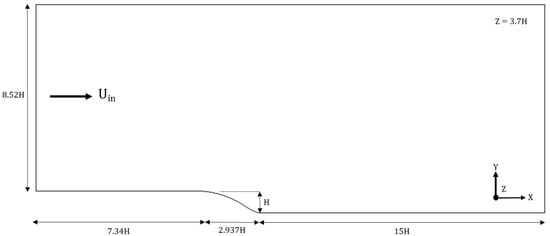
Figure 1.
Computational domain.
2.2. Computational Grid
The commercial code Star CCM+ was used to build the computational grid following the best practice guidelines [41].
Three different grids were tested to ascertain a level of accuracy suitable for the IDDES model. For all grids, the first near-wall cell height for the lower wall was selected to ensure y+ < 1. A coarser grid with a y+ ~ 25 covers the boundary on the upper wall. The rationale for this is that it is far enough away from the region of interest to have any effect on the results [28].
The grids have been designed so that the cell aspect ratio in the LES regions of interest is as close to 1 as possible, which satisfies the criteria that the grid is isotropic in these regions. The upstream section has also been treated in this way as to preserve synthetic turbulent eddies as they travel downstream to the step. This is illustrated in Figure 2, where the coarse grid is shown for clarity.
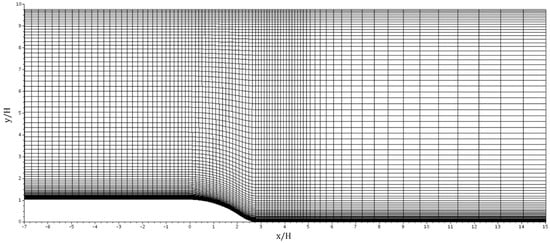
Figure 2.
Computational grid (coarse grid shown for clarity).
2.3. Numerical Method
The hybrid RANS-LES approach uses the IDDES model [37] based on the k-ω SST model with improved coefficients [42]. The transport equations for the turbulent kinetic energy and specific dissipation rate are as follows:
and
with the IDDES length scale defined as follows:
where the length scale for RANS and LES are defined as follows:
respectively.
The grid scale Δ is defined as follows:
and the blending function is defined as follows:
When the simulation has inflow turbulent content that is close to 1, the model automatically switches to the WMLES branch of the code. As reduces to zero, the DDES mode is activated. Detailed formulations of all functions and coefficients can be found in Shur et al. [37] and Gritskevich et al. [42].
For the numerical scheme we use both a bounded central scheme [43] and the hybrid scheme (Travin et al. [33]) which is defined as follows:
where and are the central and upwind differences, respectively, and
and
The turbulent length scale lturb is found from the eddy viscosity and a combination of the magnitudes of mean strain (S) and vorticity (Ω) as defined by the following:
where
The characteristic convective time is
, which is defined as l/U0, and the parameter g is used to ensure the upwind scheme is dominant in the disturbed irrotational flow regions where Ω << 1 and S > 0:
Finally, the constants are as follows:
All IDDES simulations were run for an initial 10 flow-through times before statistical averaging was taken for an additional 20 flow-through times. The commercial code Star CCM+ was used for all simulations, and these simulations were run on 32 cores of the SCIAMA High Performance Computing (HPC) facility at the University of Portsmouth.
2.4. Boundary Conditions
The upper and lower walls for the domain were set as non-slip, and the spanwise boundaries were set as periodic, as the flow is assumed to be statistically homogeneous in the spanwise direction [14]. The upper boundary is that it is far enough away from the region of interest to have any effect on the results [28]. For the inlet, a velocity inlet boundary condition was used with profiles for velocity and Reynolds stresses coming from a precursor RANS fully developed channel flow. Because of the nature of the geometry and its sensitivity to upstream conditions, the synthetic eddy method (SEM) of Jarrin et al. [39] was used to provide the turbulent fluctuations. Figure 3 shows the synthetic turbulence profile at the inlet of the domain. Initial channel flow tests showed that the Reynolds stress from the channel flow initially decayed before recovering to the correct levels; this was also observed by Jarrin et al. [39].
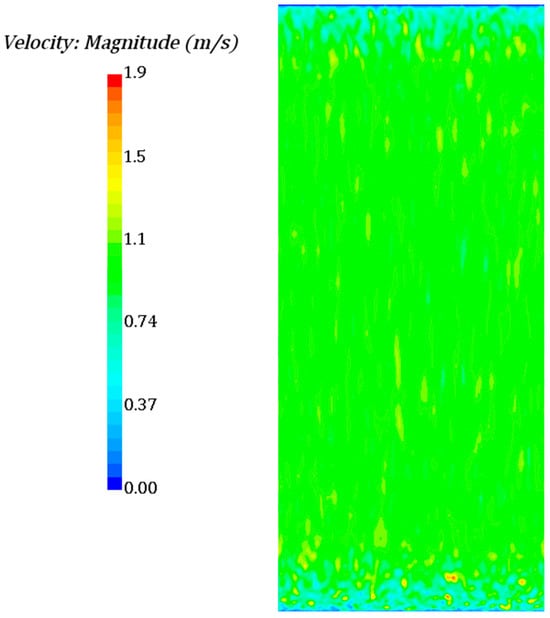
Figure 3.
Inlet velocity profile.
The adaptation length was calculated to be approximately 18H, which is far longer than the development section of the computational domain. To counteract this, the square root of the Reynolds stresses was taken and set as the inlet values, which decayed down to match the experimental and RANS results at ~−2 H. This reduced the adaptation length to approximately 5H. The outlet was set as a pressure outlet at atmospheric conditions. The turbulent length scale for the synthetic turbulence was set as 0.1δ, where δ denotes the boundary layer thickness; this choice of length scale was found to be most suitable by Davidson [44].
2.5. Modeling Setup
A precursor RANS solution using the k-ω SST was calculated as an initial flow field for the IDDES simulation to aid stability and computational time. This was also used as the reference RANS data for the results.
For the IDDES simulation, an incompressible segregated solver with an implicit second-order temporal scheme was used. The time step of ΔtU0/H = 0.025 was calculated to ensure the convective Courant–Friedrichs–Lewy number was below one in all areas of the domain, with five inner iterations per time step to ensure stability.
The isosurface of the Q-criterion colored with velocity in Figure 4 shows detail of the turbulent structures within the boundary layers of both top and bottom walls. The synthetic eddies imposed at the inlet are clearly communicated downstream to the location of the step, which is vital in the accurate prediction of the separated region. Without these eddies, the upstream boundary layer turbulence would be treated with the RANS model, which would lead to a grey area in the separation region as the LES turbulence starts to develop. This grey area leads to an even longer reattachment length compared to RANS and completely defeats the purpose of the HRLM.
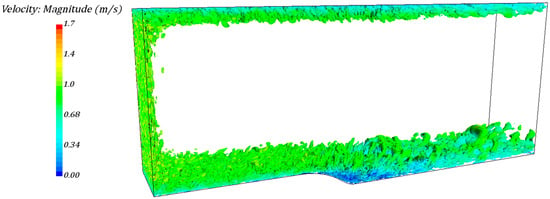
Figure 4.
Isosurface of Q-criterion = 2/s2 colored with velocity.
The locations of the RANS and LES regions of the IDDES simulation are shown in Figure 5, with the value of 1 being RANS and 0 being LES. With the synthetic eddies imposed on the inlet, the term is close to 1, and WMLES has been activated, with all but a thin layer of RANS on the top and bottom walls of the domain. The thickness of these regions for this simulation is controlled by the grid size. Upstream of the step, the separated region is thinner than that of the top wall and downstream section of the bottom wall. This is due to the requirement of keeping the grid size isotropic in these regions, as explained earlier.
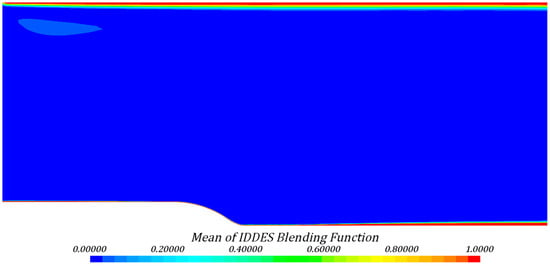
Figure 5.
IDDES blending function.
3. Results and Discussion
The simulations were run using various turbulent models, meshes, and numerical schemes, as shown in Table 1, which shows the number of cells (nx, ny, and nz) in the respective directions, the total number of cells (ntotal), the location of separation (Xsep) and reattachment (Xatt), the corresponding length of the separation (Lsep), and the percentage difference in the separation length (E) between the reference LES data. This grid convergence study shows that the fine mesh provides the result closest to the LES values and is used for all further analysis within this study. The main savings in grid resolution compared to LES are within the thin near-wall section of the boundary layer, which is covered by a RANS region. The number of grid cells for the finest grid is approximately 25% of that required for LES.

Table 1.
Comparison of the computational grid resolution.
The coefficient of friction for the bottom wall and step, Cf, is presented in Figure 6, where the step starts at x/H = 0 and ends at x/H = 2.937, and shows IDDES has good overall agreement with the reference LES results and a significant improvement over RANS, particularly in the separation region. The locations of separation and reattachment in Table 1 confirm this, with the reference LES length of separation being Lsep/H = 3.53 and IDDES being Lsep/H = 3.94; this relates to a difference of ~12% for the IDDES scheme. The maximum value of the IDDES Cf is roughly equal to the LES value, and it continues to follow this path until separation, where it predicts a slightly earlier separation, where Cf = 0. Thereafter, where Cf is negative, indicating reversed flow, it can be seen that the RANS result generally underpredicts the amount of reversed flow, whereas the IDDES overpredicts the amount of reversed flow up until the point where Cf starts to increase at x/H ~ 3, where it then starts to diverge due to the overprediction of the turbulent viscosity. This causes a larger recirculation region and ultimately a longer reattachment length. We also observe a deviation between the LES and IDDES results at x/H < ~−3, prior to the step. This is due to the synthetic turbulence, as discussed in Section 2.4; however, this is rectified prior to the start of the step and the region of interest.

Figure 6.
Coefficient of friction on the bottom wall and step.
The default numerical scheme in Star CCM+ is the hybrid scheme of Travin et al. [33], and its performance has been compared to the bounded central scheme [43] in Table 1 and Figure 7 for the fine grid. The results in Table 1 show that for the hybrid scheme, the length of separation has a difference of 22.4%, which is comparable to the difference observed using the bounded central scheme on the coarse grid. This compares to a difference of 10.4% for the bounded central scheme on the same fine mesh. These differences are highlighted in Figure 7, which shows that Cf is underpredicted up to separation compared to the bounded central scheme and just after separation nearly reattaches, which is caused by a small secondary recirculation bubble. The value of Cf is underpredicted at the lowest level of x/H ~ 4 and remains so for the rest of the boundary up to the outlet.
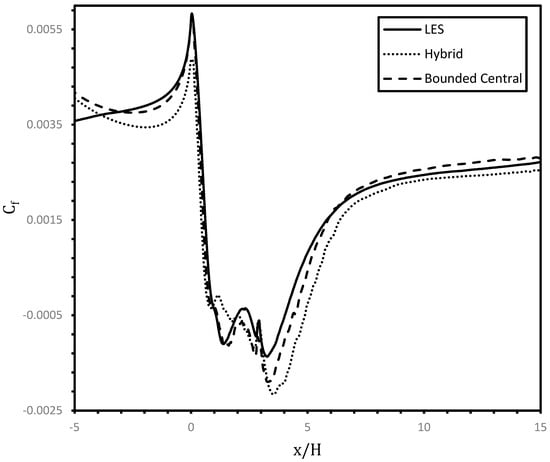
Figure 7.
Comparison of numerical scheme for coefficient of friction on bottom wall of step.
Ashton et al. [45] reported when calibrating the DDES constant using decaying isotropic turbulence that too much dissipation can cause overprediction of the separated region, and the choice of the correct numerical scheme is an important factor in accuracy. Therefore, the choice of bounded central over the hybrid scheme is recommended for this type of test case, as most of the domain is LES and only a thin section of the boundary layer is RANS. Based on this and the superior performance observed in Table 1 and Figure 7, the bounded central scheme will be used for all IDDES results shown hereafter.
Figure 8 shows the pressure coefficient, where the reference pressure is taken at the bottom left-hand corner of the domain. Both IDDES and RANS are able to predict the initial pressure coefficient up to x/H ~ 0 well, but both models overpredict the minimum value of Cp just before separation. Past the separation point at x/H ~ 0.8, there is a region up to x/H ~ 8 where both models show mixed results. Initially the RANS overpredicts Cp up until x/H ~ 2, where it starts to underpredict Cp until x/H ~ 7, where it eventually recovers to approximately the same level as the LES result. The value of Cp for the IDDES model in the region 1 < x/H < 4, although showing the same general shape as LES, is underpredicted, but past x/H ~ 4, it is a closer match than RANS before it, predicting slightly lower past x/H ~ 7.
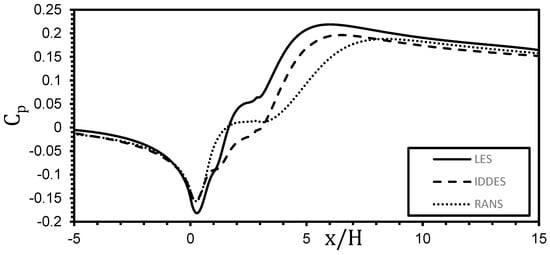
Figure 8.
Coefficient of pressure.
Figure 9 and Figure 10 show the velocity profiles for the U and V directions, respectively. The results, again, are in reasonable agreement with the LES data and are generally improved with respect to the RANS data but do show a deviation in the separation region. In Figure 9, the effect of the earlier separation and later reattachment of both the RANS and IDDES can be observed in the region y/H < 1. Here, at x/H = 1, the velocity predicted by RANS and IDDES is similar and slightly underpredicts the LES velocity, which is consistent with the LES separating later. At x/H = 2, a similar effect is observed with a larger underprediction, and in particular, the region of negative velocity extends over a larger region for the RANS and IDDES, again consistent with an earlier separation compared to LES and so a thicker recirculation region behind the step. This profile continues at x/H = 3–5, but here the IDDES profile progresses from initially being comparable to the RANs (x/H < 3) to a much closer agreement at x/H = 5. The similarity between the LES and IDDES in this region explains why the IDDES provides a closer match of the reattachment compared to RANS. A similar pattern is shown with regard to the V velocity profile in Figure 10.
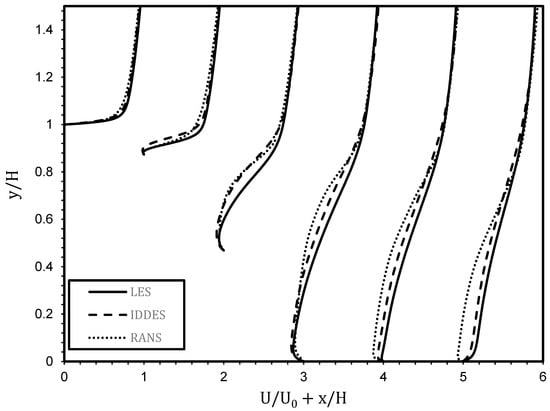
Figure 9.
Streamwise velocity (U).

Figure 10.
Wall-normal velocity (V).
Figure 11, Figure 12, Figure 13 and Figure 14 show the resolved Reynolds stress profiles. There is reasonable agreement for the IDDES simulations with the reference LES data at the point before separation, which shows the boundary layer upstream has been modeled correctly. After separation there is a slight overprediction of Reynolds stresses, which has the effect of underpredicting the skin friction coefficient, as seen in Figure 6. This is a typical problem for this type of flow, according to Mockett et al. [21]. This is in contrast to the RANS simulations, where the Reynolds stress profiles are underpredicted, generally by more than the IDDES overpredictions.
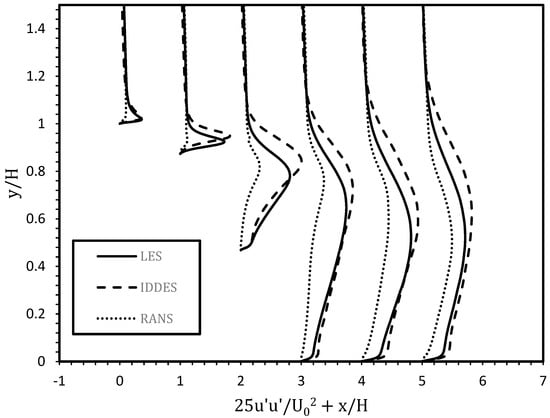
Figure 11.
Profile u′u′.

Figure 12.
Profile v′v′.
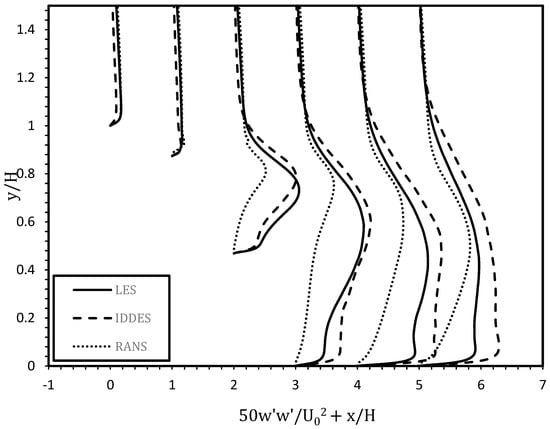
Figure 13.
Profile w′w′.
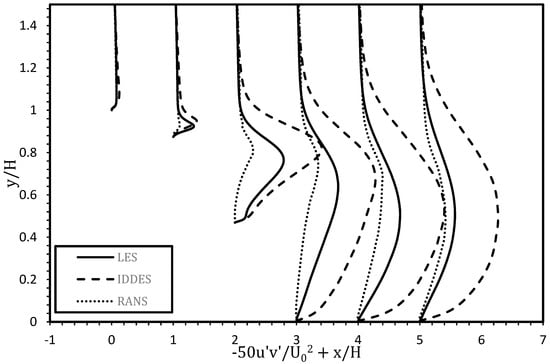
Figure 14.
Profile −u′v′.
The results presented demonstrate the ability of IDDES to simulate the separation and reattachment on a backward-facing step to a better accuracy than RANS, without requiring the high-resolution grids, and consequently computationally expensive, required for LES simulations. The fine grids and long computational run times required for LES have prevented it from being routinely adopted by industry, which has relied predominantly on RANS simulations. Identifying the suitability of IDDES, which is not available within commercial software packages, and demonstrating that it can be applied with improved accuracy over RANS in test cases such as the curved backward-facing step will lead to its application in a range of industrial applications where flow separation from curved surfaces occurs. One area where this is of particular importance is when simulating air flow over an aerofoil [46], where separation of the air flow reduces lift and increases drag. Thus, accurate simulation is important when evaluating the aerofoil performance and designing new systems with improved efficiency. This not only applies to the aviation industry but also to the renewable energy sector when applied to wind turbines [47] and tidal energy generation [48]; compressor design [49] with applications in areas such as air conditioning and heat pumps; and hydrofoils for the latest generation of yachts [50].
4. Conclusions
The IDDES model has been tested for a curved backward-facing step using a mesh, which, although somewhat finer than is required for RANS, is still more computationally efficient than running an LES simulation. The results show reasonable agreement with LES terms of the mean quantities of the flow, showing IDDES provides a cost-effective approach for industry to implement simulations of this kind using commercial software. The separation length has ~12% difference compared to the reference LES, which is significantly better than the RANS simulation, which differs by more than 50%. The skin friction coefficients show close agreement with LES over the majority of the domain other than an initial region with −5 < x/H < −0.25, prior to the step, with a maximum deviation of ~0.0015 close to the re-attachment point. In contrast, the RANS skin friction coefficients are in good agreement with the LES values through the step and the initial separation region before diverging significantly prior to reattachment. In contrast, the pressure coefficient has been predicted less favorably with a significant difference behind the step. Despite the differences, the IDDES results are generally closer to the LES results, with a maximum difference of ~0.07, compared to a maximum difference of the RANS results of ~0.12. Both predictions using the IDDES model are shown to be improvements over the use of RANS. The Reynolds stress terms typically showed the IDDES simulation results closer to the LES values, both in terms of magnitude and profile, although this is not the case for u′v′.
The use of the synthetic eddy method on the inlet has been key in generating the correct boundary layer upstream of the step and making the model work as a WMLES, but the artificial nature of its prescription is not particularly useful in terms of a more natural development of the adaptation length. This could possibly be improved by increasing the adaptation length from 5H to 18H; however, this would significantly increase the computational cost of the simulation. Alternatively, an upgrade to this model like that of Poletto et al. [51] or the development of a synthetic turbulence generator by Shur et al. [52], which have been reported to improve this, would be interesting to test. Additionally, the turbulent length scale for the synthetic turbulence was set to 0.1δ following Davidson [44]. It would be interesting to investigate the sensitivity of the results to this choice. Overall, it has been shown that IDDES can be implemented for flows with separation and reattachment from a curved surface with a relatively large radius of curvature. The results show a reasonable level of accuracy when the simulations are run on a mesh considerably coarser than that required for LES. It is hoped that this work will lead to a better adoption of the IDDES approach to related industrial applications in an efficient manner.
Author Contributions
Conceptualization, M.R.M., J.K., and J.M.B.; methodology, M.R.M., J.K., and J.M.B.; software, M.R.M.; validation, M.R.M.; formal analysis M.R.M., J.K., and J.M.B.; investigation, M.R.M.; resources, J.K. and J.M.B.; data curation, M.R.M.; writing—original draft preparation, M.R.M.; writing—review and editing, J.K. and J.M.B.; visualization, M.R.M.; supervision, J.K. and J.M.B.; project administration, J.K. and J.M.B. All authors have read and agreed to the published version of the manuscript.
Funding
This research received no external funding.
Data Availability Statement
Dataset available on request from the authors.
Acknowledgments
The authors would like to thank Siemens for the use of their code Star CCM+. Numerical computations were performed on the Sciama High Performance Compute (HPC) cluster, which is supported by the ICG, SEPNet, and the University of Portsmouth.
Conflicts of Interest
The authors declare no conflicts of interest.
References
- Menter, F.; Hüppe, A.; Matyushenko, A.; Kolmogorov, D. An Overview of Hybrid RANS–LES Models Developed for Industrial CFD. Appl. Sci. 2021, 11, 2459. [Google Scholar] [CrossRef]
- Han, Y.; Liu, M.; Tan, L. A review on the application of hybrid RANS-LES methods in hydraulic machinery. Ocean. Eng. 2024, 305, 117943. [Google Scholar] [CrossRef]
- Abdolahipour, S. Review on flow separation control: Effects of excitation frequency and momentum coefficient. Front. Mech. Eng. 2024, 10, 1380675. [Google Scholar] [CrossRef]
- Abdolahipour, S. Effects of low and high frequency actuation on aerodynamic performance of a supercritical airfoil. Front. Mech. Eng. 2023, 9, 1290074. [Google Scholar] [CrossRef]
- Abdolahipour, S.; Mani, M.; Shams, T.A. Pressure Improvement on a Supercritical High-Lift Wing Using Simple and Modulated Pulse Jet Vortex Generator. Flow Turbul. Combust. 2022, 109, 65. [Google Scholar] [CrossRef]
- Abdolahipour, S.; Mani, M.; Taleghani, A.S. Experimental Investigation of Flow Control on a High-Lift Wing Using Modulated Pulse Jet Vortex Generator. J. Aerosp. Eng. 2022, 35, 05022001. [Google Scholar] [CrossRef]
- Taleghani, A.S.; Hesabi, A.; Esfahanian, V. Numerical Study of Flow Control to Increase Vertical Tail Effectiveness of an Aircraft by Tangential Blowing. Int. J. Aeronaut. Space Sci. 2025, 26, 785. [Google Scholar] [CrossRef]
- Ho, H.H.; Shirinzad, A.; Essel, E.E.; Sullivan, P.E. Synthetic Jet Actuators for Active Flow Control: A Review. Fluids 2024, 9, 290. [Google Scholar] [CrossRef]
- Bhaduri, S.; Ray, A.; De, A.; Sugarno, M.I. Flow control in a confined supersonic cavity flow using subcavity. Front. Mech. Eng. 2024, 10, 1378433. [Google Scholar] [CrossRef]
- Gustafsson, E.; Andersson, M. Investigating the Effects of Labeled Data on Parameterized Physics-Informed Neural Networks for Surrogate Modeling: Design Optimization for Drag Reduction over a Forward-Facing Step. Fluids 2024, 9, 296. [Google Scholar] [CrossRef]
- MacDougall, C.Y.; Piomelli, U.; Ambrogi, F. Evaluation of Turbulence Models in Unsteady Separation. Fluids 2023, 8, 273. [Google Scholar] [CrossRef]
- Lu, W.; Chan, L.; Ooi, A. Spectral Analysis of Confined Cylinder Wakes. Fluids 2025, 10, 84. [Google Scholar] [CrossRef]
- Jovic, S.; Driver, D.M. Backward-Facing Step Measurements at Low Reynolds Number, Reh = 5000. NASA Technical Memorandum 108807. 1994. Available online: https://ntrs.nasa.gov/citations/19940028784 (accessed on 10 January 2025).
- Le, H.; Moin, P.; Kim, J. Direct Numerical Simulation of Turbulent Flow over a Backward-Facing Step. J. Fluid Mech. 1997, 330, 349–374. [Google Scholar] [CrossRef]
- Vogel, J.C.; Eaton, J.K. Combined heat transfer and fluid dynamic measurement downstream of a backward-facing step. J. Heat. Trans. 1985, 107, 922–927. [Google Scholar] [CrossRef]
- Breuer, M.; Peller, N.; Rapp, C.; Manhart, M. Flow over periodic hills—Numerical and experimental study in a wide range of Reynolds numbers. Comput. Fluids 2009, 38, 433–457. [Google Scholar] [CrossRef]
- Mellen, C.P.; Fröhlich, J.; Rodi, W. Large-eddy simulation of the flow over periodic hills. In Proceedings of the 16th IMACS World Congress, Lausanne, Switzerland, 21–25 August 2000. [Google Scholar]
- Fröhlich, J.; von Terzi, D. Hybrid LES/RANS methods for the simulation of turbulent flows. Prog. Aerosp. Sci. 2008, 44, 349–377. [Google Scholar] [CrossRef]
- Jakirlić, S.; Jester-Zürker, R.; Tropea, C. 9th ERCOFTAC/IAHR/COST Workshop on Refined Turbulence Modelling. ERCOFTAC Bulletin, No. 55. Darmstadt University of Technology. 2001, pp. 36–43. Available online: https://www.ercoftac.org/downloads/sig15/report_9th_sig15_workshop_darmstadt_ercoftac_bulletin_no55_2002.pdf (accessed on 10 January 2025).
- Manceau, R.; Bonnet, J.P.; Leschziner, M.A.; Menter, F. 10th Joint ERCOFTAC(SIG-15)/IAHR/QNET-CFD Workshop on Refined Flow Modeling. France: Université de Poitiers. 2002. Available online: https://www.ercoftac.org/downloads/bulletin-docs/ercoftac_bulletin_57.pdf (accessed on 10 January 2025).
- Mockett, C.; Fuchs, M.; Thiele, F. Progress in DES for wall-modelled LES of complex internal flows. Comput. Fluids 2012, 65, 44–55. [Google Scholar] [CrossRef]
- ERCOFTAC Website. Available online: http://www.ercoftac.org/ (accessed on 10 January 2025).
- Greenblatt, D.; Paschal, K.B.; Yao, C.-S.; Harris, J.; Schaeffler, N.W.; Washburn, A.E. A Separation Control CFD Validation Test Case, Part 1: Baseline and Steady Suction. In Proceedings of the 2nd AIAA Flow Control Conference, Portland, OR, USA, 28 June 2004; Available online: https://ntrs.nasa.gov/api/citations/20040084074/downloads/20040084074.pdf (accessed on 10 July 2024).
- Saric, S.; Jakirlic, S.; Djugum, A.; Tropea, C. Computational Analysis of a Locally Forced Flow over a Wall-Mounted Hump at High-Re Number. Int. J. Heat Fluid Flow 2006, 27, 707–720. [Google Scholar] [CrossRef]
- You, D.; Wang, M.; Moin, P. Large-Eddy Simulation of Flow over a Wall-Mounted Hump with Separation Control. AIAA J. 2006, 44, 2571–2577. [Google Scholar] [CrossRef]
- Davidson, L. The PANS k-e Model in a Zonal Hybrid RANS-LES Formulation. Int. J. Heat Fluid Flow 2014, 46, 112–126. [Google Scholar] [CrossRef]
- McConnell, M.R.; Knight, J.; Buick, J.M. Improved Delayed Detached-Eddy Simulation of Turbulent Vortex Shedding in Inert Flow over a Triangular Bluff Body. Fluids 2024, 9, 246. [Google Scholar] [CrossRef]
- Bentaleb, Y.; Lardeau, S.; Leschziner, M.A. Large-eddy simulation of turbulent boundary-layer separation from a rounded step. J. Turbul. 2012, 13, N4. [Google Scholar] [CrossRef]
- Zhang, S.; Zhong, S. An experimental investigation of turbulent flow separation control by an array of synthetic jets. In Proceedings of the 5th Flow Control Conference, Chicago, IL, USA, 28 June–1 July 2010. [Google Scholar] [CrossRef]
- Lardeau, S.; Leschziner, M.A. The interaction of round synthetic jets with a turbulent boundary layer separating from a rounded ramp. J. Fluid Mech. 2011, 683, 172. [Google Scholar] [CrossRef]
- Spalart, P.R.; Jou, W.-H.; Strelets, M.; Allmaras, S.R. Comments on the feasibility of LES for wings, and on a hybrid RANS/LES approach. In Proceedings of the First AFOSR International Conference on DNS/LES, Ruston, LA, USA, 4–8 August 1997. [Google Scholar]
- Spalart, P.R.; Allmaras, S.R. A One-Equation Turbulence Model for Aerodynamic Flows. Rech. Aerosp. 1994, 1, 5–21. [Google Scholar]
- Travin, A.; Shur, M.; Strelets, M.; Spalart, P.R. Physical and Numerical Upgrades in the Detached-Eddy Simulation of Complex Turbulent Flows. In Advances in LES of Complex Flows; Fluid Mechanics and Its Applications; Friedrich, R., Rodi, W., Eds.; Springer: Dordrecht, The Netherlands, 2002; Volume 65. [Google Scholar] [CrossRef]
- Menter, F.R. Zonal two-equation k–ω turbulence models for aerodynamic flows. In Proceedings of the 23rd Fluid Dynamics, Plasmadynamics, and Lasers Conference, Orlando, FL, USA, 6–9 July 1993. AIAA Paper 2906. [Google Scholar] [CrossRef]
- Spalart, P.R.; Deck, S.; Shur, M.L.; Squires, K.D.; Strelets, M.K.; Travin, A.K. A new version of detached-eddy simulation, resistant to ambiguous grid densities. Theor. Comput. Fluid Dyn. 2006, 20, 181–195. [Google Scholar] [CrossRef]
- Nikitin, N.V.; Nicoud, F.; Wasistho, B.; Squires, K.D.; Spalart, P.R. An approach to wall modeling in large-eddy simulations. Phys. Fluids 2000, 12, 1629–1632. [Google Scholar] [CrossRef]
- Shur, M.L.; Spalart, P.R.; Strelets, M.K.; Travin, A.K. A hybrid RANS-LES approach with delayed-DES and wall-modelled LES capabilities. Int. J. Heat Fluid Flow 2008, 29, 1638–1649. [Google Scholar] [CrossRef]
- Gritskevich, M.S.; Garbaruk, A.V.; Schütze, J.; Menter, F.R. Development of DDES and IDDES Formulations for the k-ω Shear Stress Transport Model. Flow Turbul. Combust. 2012, 88, 431–449. [Google Scholar] [CrossRef]
- Jarrin, N.; Benamadouche, S.; Laurence, D.; Prosser, R. A synthetic-eddy-method for generating inflow conditions for large large eddy simulations. Int. J. Heat Fluid Flow 2006, 27, 585–593. [Google Scholar] [CrossRef]
- Han, Y.; Ding, G.; He, Y.; Wu, J.; Le, J. Assessment of the IDDES method acting as wall-modeled LES in the simulation of spatially developing supersonic flat plate boundary layers. Eng. Appl. Comput. Fluid Mech. 2017, 12, 89–103. [Google Scholar] [CrossRef]
- Spalart, P.; Streett, C. Young-Person’s Guide to Detached-Eddy Simulation Grids. NASA Contractor Report 211032. 2001. Available online: https://ntrs.nasa.gov/api/citations/20010080473/downloads/20010080473.pdf (accessed on 2 May 2025).
- Gritskevich, M.; Garbaruk, A.; Menter, F. Fine-tuning of DDES and IDDES formulations to the k-ω shear stress transport model. Prog. Flight Phys. 2013, 5, 23–42. [Google Scholar] [CrossRef]
- Leonard, B.P. The ULTIMATE conservative difference scheme applied to unsteady one-dimensional advection. Comp. Methods Appl. Mech. Eng. 1991, 88, 17–74. [Google Scholar] [CrossRef]
- Davidson, L. Using isotropic synthetic fluctuations as inlet boundary conditions for unsteady simulations. Adv. Appl. Fluid Mech. 2007, 1, 1–35. [Google Scholar]
- Ashton, N.; West, A.; Lardeau, S.; Revell, A. Assessment of RANS and DES methods for realistic automotive models. Comput. Fluids 2016, 128, 1–15. [Google Scholar] [CrossRef]
- Jones, C. Investigation of Flow Separation and its Effects on Aerodynamic Performance. Fluid Mech. Open Access 2023, 10, 271. [Google Scholar]
- Akhter, M.Z.; Omar, F.K. Review of Flow-Control Devices for Wind-Turbine Performance Enhancement. Energies 2021, 14, 1268. [Google Scholar] [CrossRef]
- Kundu, P. Effects of circular trailing edge with the dimple on flow separation of NACA S1210 hydrofoil. Proc. Inst. Mech. Eng. Part C J. Mech. Eng. Sci. 2020, 234, 3600–3613. [Google Scholar] [CrossRef]
- Wang, M.; Li, Z.; Yang, C.; Han, G.; Zhao, S.; Lu, X. Numerical investigations of the separated transitional flow over compressor blades with different loading distributions. Aerosp. Sci. Technol. 2020, 106, 106113. [Google Scholar] [CrossRef]
- D’Ubaldo, O.; Ghelardi, S.; Rizzo, C.M. FSI simulations for sailing yacht high performance appendages. Ships Offshore Struct. 2020, 16, 200–215. [Google Scholar] [CrossRef]
- Poletto, R.; Craft, T.; Revell, A. A New Divergence Free Synthetic Eddy Method for the Reproduction of Inlet Flow Conditions for LES. Flow Turbul. Combust. 2013, 91, 519–539. [Google Scholar] [CrossRef]
- Shur, M.; Spalart, P.; Strelets, M.; Travin, A. Synthetic Turbulence Generators for RANS-LES Interfaces in Zonal Simulations of Aerodynamic and Aeroacoustic Problems. Flow Turbul. Combust. 2014, 93, 63–92. [Google Scholar] [CrossRef]
Disclaimer/Publisher’s Note: The statements, opinions and data contained in all publications are solely those of the individual author(s) and contributor(s) and not of MDPI and/or the editor(s). MDPI and/or the editor(s) disclaim responsibility for any injury to people or property resulting from any ideas, methods, instructions or products referred to in the content. |
© 2025 by the authors. Licensee MDPI, Basel, Switzerland. This article is an open access article distributed under the terms and conditions of the Creative Commons Attribution (CC BY) license (https://creativecommons.org/licenses/by/4.0/).